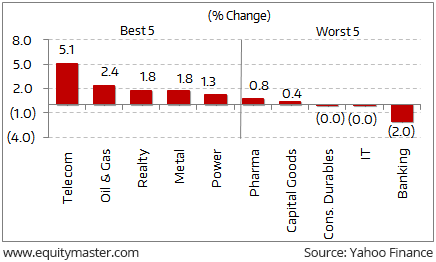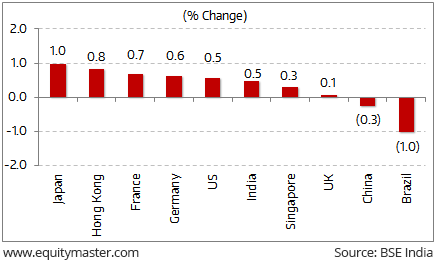The Dow Jones Industrial Average briefly broke above the 23,000-point mark for the first time on Tuesday, driven by strong earnings from UnitedHealth and Johnson & Johnson, but finished the session just below that milestone. The US markets were up 0.5% during the week.
UK’s FTSE was flat following comments by Bank of England policymakers which were taken as dovish by market participants. On the data front, Britain’s inflation rate soared to a fresh five-and-a-half-year high in September. The consumer prices index rose 3% last month, up from 2.9% in August.
Back in Asia, markets were steady during the week as investors in the region looked to China’s Party Congress for signs on future policy direction in the world’s second-largest economy. The stock market in China was down by 0.3% during the week. Whereas, the benchmark Nikkei 225 index was up by 1% during the week after posting gains for the 12th straight session on Wednesday.
Oil prices rose during the week, lifted by a fall in US crude inventories and concerns that tensions in the Middle East could disrupt supplies.
Key World Markets During the Week

Back home, the Indian indices closed marginally higher ahead of the festive season. The BSE Sensex was up by 0.5% for the week. Midcap and Smallcap stocks outperformed the frontline indices to gain 0.9% and 1.4%, respectively.
Indian share markets are closed on Thursday and Friday, but will open for a one-hour special trading session on Thursday evening to mark Diwali, the Indian festival of lights.
Majority of the sector indices ended the week on a positive note. Stocks from telecom and oil & gas sector gained the most.
BSE Indices During the Week

Now let us discuss some key economic and industry developments during the week gone by
In news from the economy, days after the International Monetary Fund (IMF) pared India’s GDP growth projection for the year 2017 and 2018, its Managing Director Christine Lagarde has expressed confidence that the series of reforms like demonetisation and Goods and Services Tax (GST) regime have put country’s economy on a very solid track in the mid-term.
Describing these structural reforms as ‘monumental effort’, she said that it is hardly surprising that there is a little bit of a short-term slowdown as a result, but for the medium term, they see a very solid track ahead for the Indian economy. IMF chief further indicated that metrics of inflation, fiscal deficit and structural reforms would deliver jobs. She also said that they hope that the combination of fiscal because the deficit has been reduced, inflation has been down significantly, and the structural reforms will actually deliver the jobs that the Indian population, particularly the young Indian people expect in the future.
Last week, the IMF in its latest flagship World Economic Outlook has lowered India’s Gross Domestic Product (GDP) growth forecast for 2017 by 0.5 percentage points to 6.7%, primarily because of the lingering impact of demonetisation as well as the disruption caused by the GST regime. It has also trimmed the growth projection for 2018 to 7.4% from 7.7% forecasted earlier in April and June.
In the other news, according to data released by the Central Statistics Office (CSO), retail inflation as measured by the Wholesale Price Index (WPI) eased to 2.6% in September, as compared to a sharp rise of 3.2% in August 2017. Wholesale inflation rate, measured by the wholesale price index (WPI), is a marker for price movements in bulk buys for traders and broadly mirrors trends in shop-end prices.









Leave A Comment